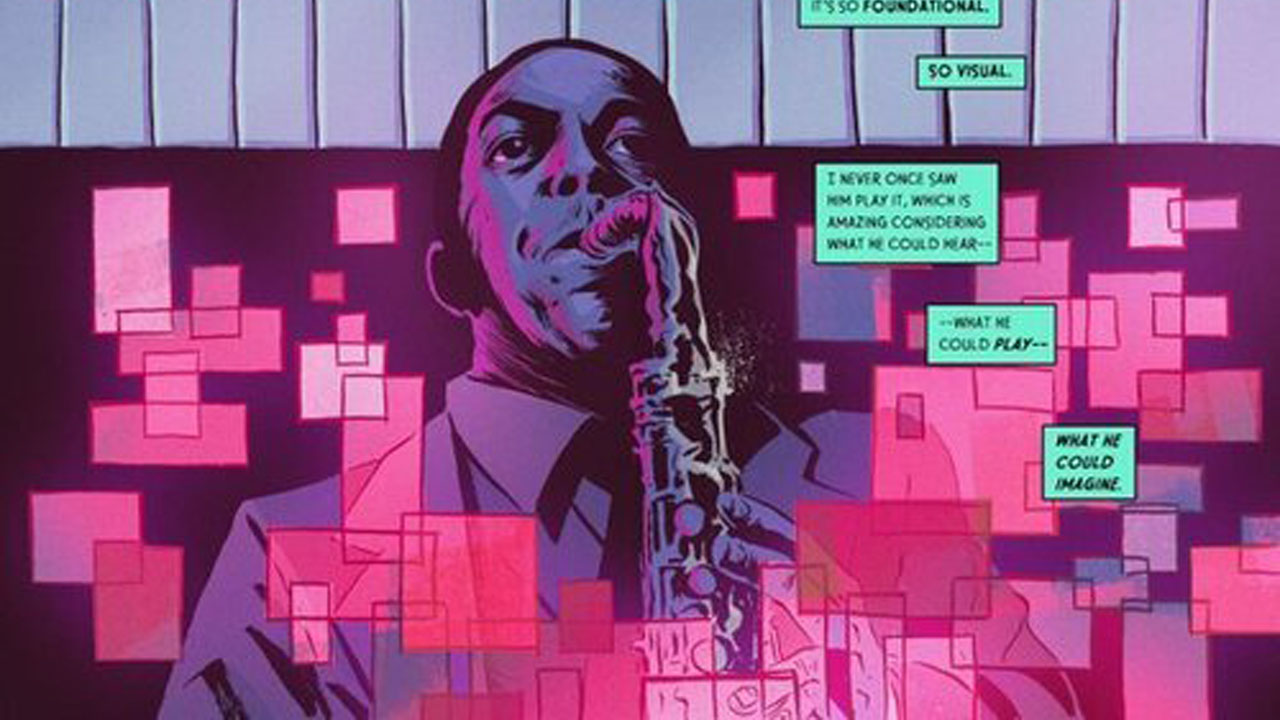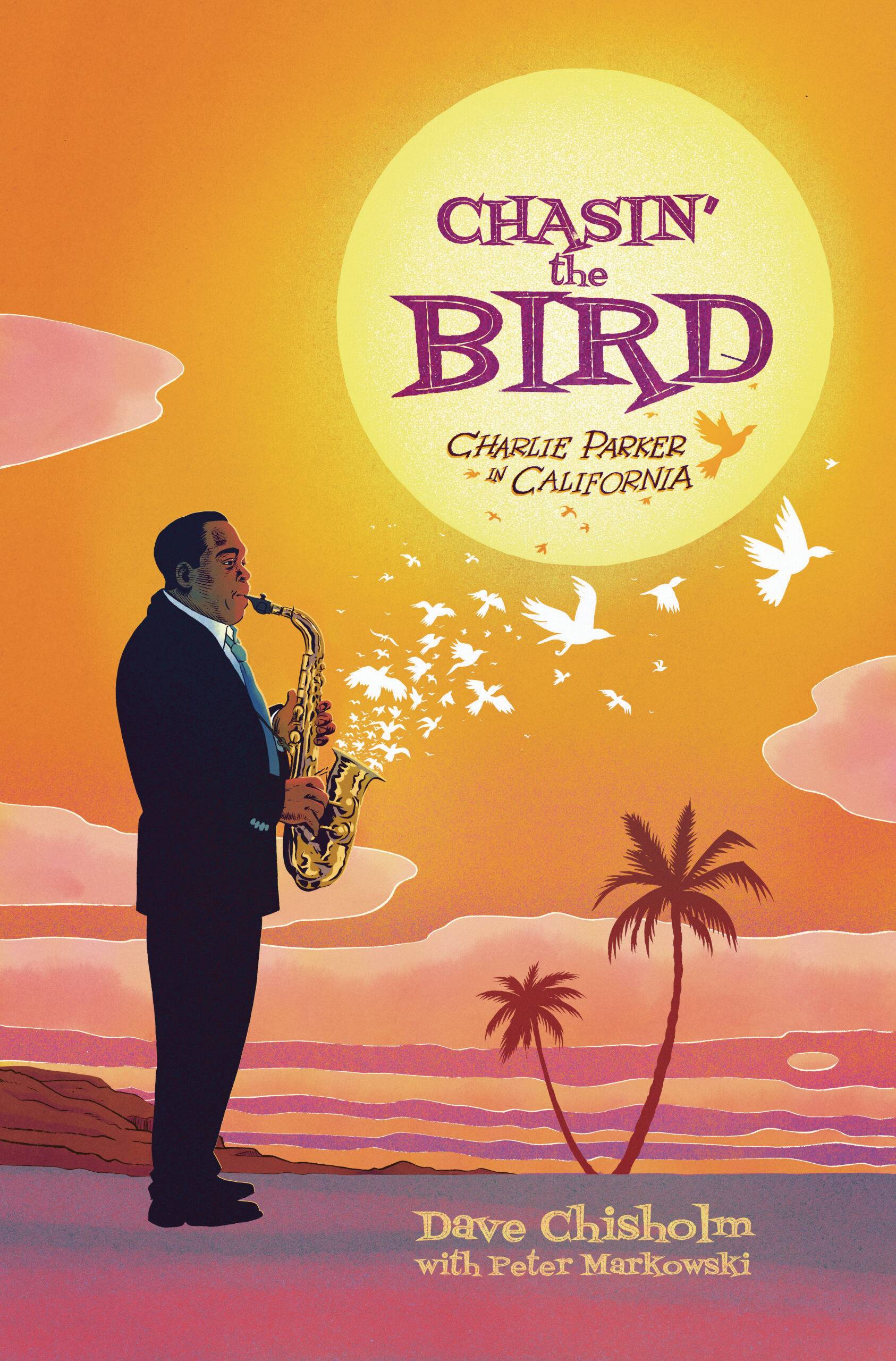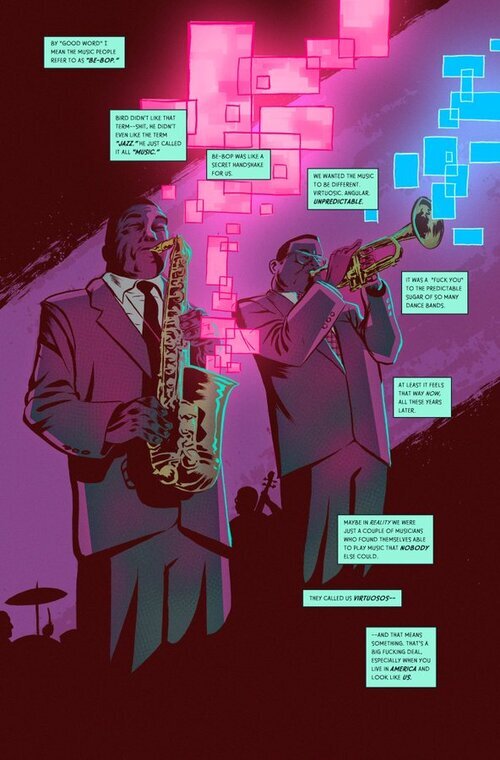Best Shots Review - Chasin' The Bird: Charlie Parker in California
From Dave Chisholm and Peter Markowski

Chasin' The Bird: Charlie Parker in California
Written by Dave Chisholm
Art by Dave Chisholm and Peter Markowski
Lettering by Dave Chisholm
Published by Z2 Comics
'Rama Rating: 9 out of 10

Like music-biography movies (think Bohemian Rhapsody or Rocketman for two recent examples), comic music bios often get confused about what they are trying to accomplish. Even the fantastic-looking David Bowie bio-comic by Mike Allred and Steve Horton from earlier this year ended up being more of a surface-level act of hero worship rather than a deeper exploration of the man and his art. Now in the second high-profile music bio comic in 2020, Dave Chisholm finds a path to use the events of the great jazz saxophonist Charlie "Bird" Parker's life to tell us a story about the flawed, troubled, and talented man that shows us that we cannot know about this man the way that we truly want to.
Focused on a couple of years in the late '40s, when Parker first went out to California as a sideman for Dizzy Gillespie, Chisholm presents six different perspectives of Bird, but those perspectives are only as limited as what Bird revealed to them at the time. Gillespie is his boss, the bandleader; Zorthian is an artist and a fan; Claxton is a photographer and someone who wants to be in the scene; MacDonald is a lover, one of many, who introduced Parker to new artist worlds; John Coltrane, an up-and-comer at the time who has much to learn from Bird; and Russell, the man who wanted to turn his love of jazz into the business of jazz. These six people give us a glimpse into the artist Charlie Parker, but Chisholm is upfront at the beginning of the book: "How can anyone describe the whole until every part is considered?"

Yet even Chisholm is unable to give us every part that needs to be considered. Parker was haunted by addiction during this time, and while it is hinted at and talked around, Chisholm keeps his distance from Parker's drug use. It's treated as an element of this man but never as a direct cause of his troubles. Chisholm's vision, while informed by his six points-of-view, is still limited and myopic, a point he probably wouldn't argue against.
Shortly after arriving in California with Gillespie, Parker just vanished. With the understanding that there's more to Parker than anyone knows, Chisholm finds his story in that mystery in these unknown months of Parker's life. Even the details there are fuzzy for each of the narrators, because none of them knew the full story. It may have only been a few months or it may have been more than a year where no one heard from Parker. Russell was with Bird for those missing months, taking care of Parker, but even he could not know everything that Parker was experiencing.
Chisholm's facts are uncertain, and he leans into that. His story isn't a typical biography; he's not trying to show Parker's life from birth, discovering music and heroin, and struggling with both until his death. This isn't the definitive "Life and Times of Charlie Parker." This is a story based on "true-life events," but it's still a story about one man and this specific time in his life.

Chisholm and colorist Peter Markowski take on the unenviable task of trying to convey music in the purely visual medium of comics. Exploring the musical diversity of Parker through their art — note how many times Parker finds inspiration in classical music is identified in this book — Chisholm and Markowski perform their own version of jazz here. Like any good jazz band, Markowski's colors lay a beat and a foundation for Chisholm to solo off on, to go where the inspiration strikes him. While it’s impossible to draw music, they find a close visual approximation to it in how they move around in and color these pages. Each chapter, or "Chorus" as they are titled, has its own style and visual identity, as Chisholm and Markowski use the changing art styles to pull out a mood, a riff, and a personality for each piece. The art, with shades of Nate Powell, Ian Bertram, Frank Quitely, and Darwin Cooke among others, emphasizes the different perspectives of Parker that we're seeing in this story.
Comic deals, prizes and latest news
Get the best comic news, insights, opinions, analysis and more!
There is an underlying structure to this book, reinforced by the framing sequence set in a club on the night of Parker's return to the stage after his disappearance. Between each chapter, Chisholm returns to this club, reorienting the story before launching into the next riff. These short sequences in the jazz club, building anticipation for the return of Bird, allow each chapter to be its own thing, it's own movement in the larger story of Charlie Parker. Markowski's ever-present purples — hints of the color are almost on every page — are the solid rhythm section of this comic, providing a return point for the artists, the readers, and for every new progression of this piece of art.
Chasin' The Bird: Charlie Parker in California is not a full view of the man. As a collection of different perspectives of the musician, each one wants something different from the artist, and those color the viewpoints of each of the narratives. They all want something different from him but they all want something. They're looking for some love, some validation, some partnership, and even some friendship from a man who was all about the music. They wanted him, but did he want them at all? Chisholm only gives us these outside views of the artist. We're left to put together a puzzle of who Charlie Parker was during this year, but the puzzle is intentionally incomplete.
Scott is a regular contributor for Panel Patter, GamesRadar, and Newsarama, covering comic books since 2002. He specialises in comic book reviews, and also runs the blog I Lost It At the Comic Shop.


